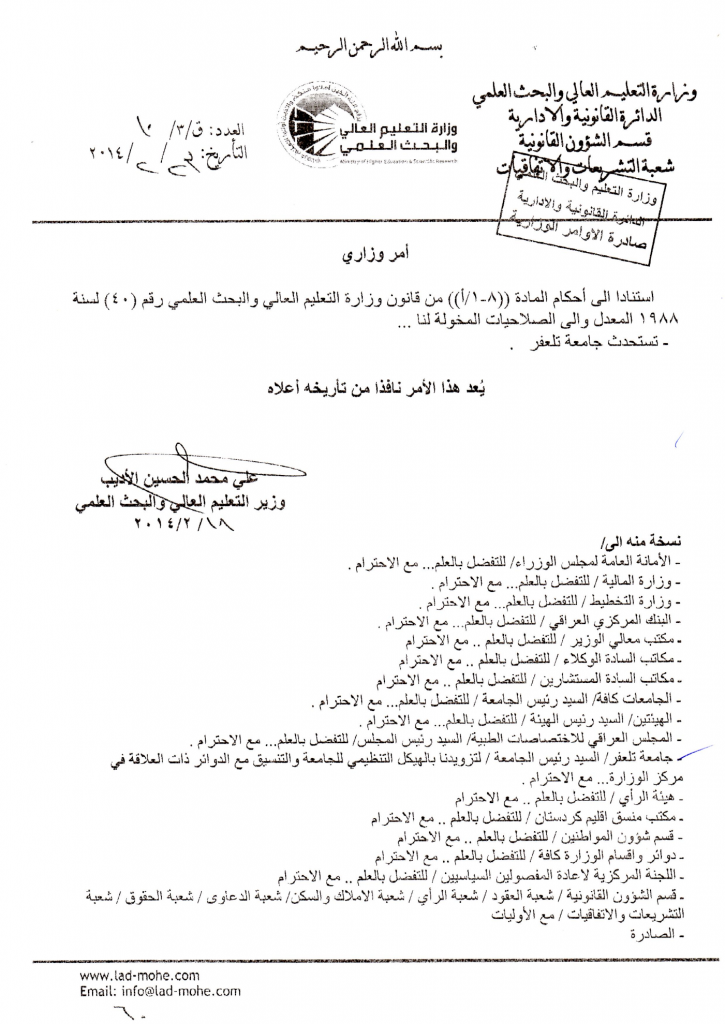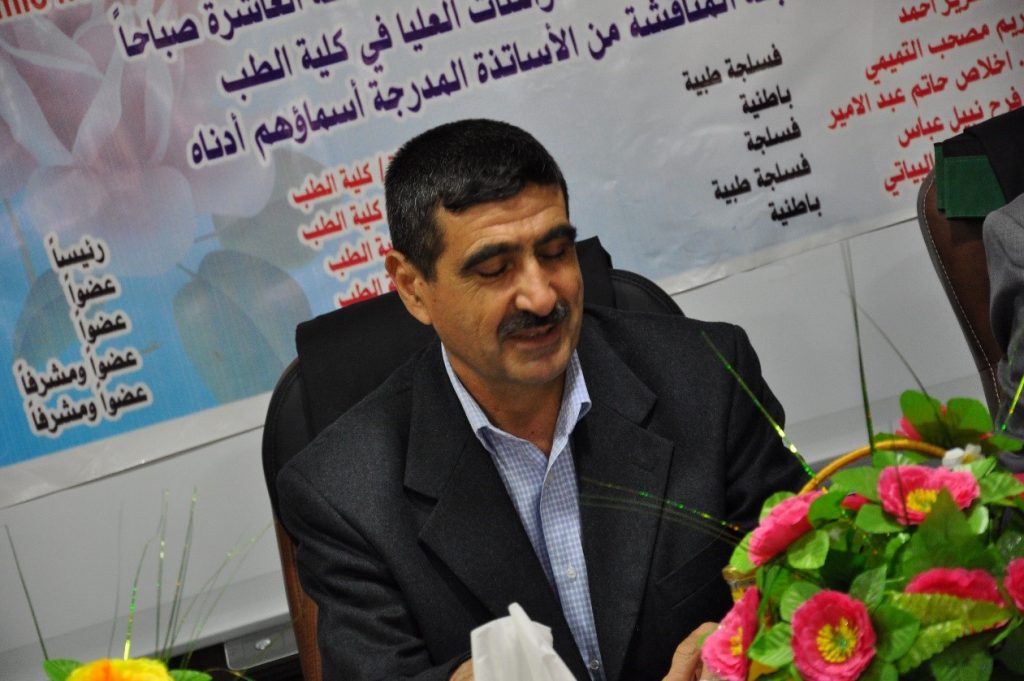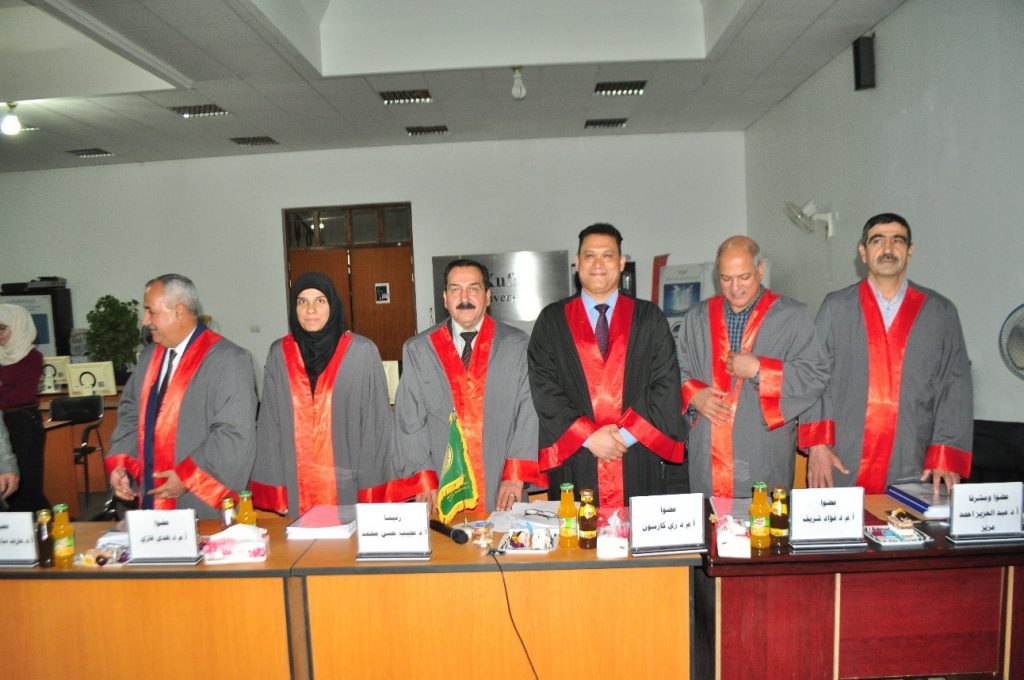| Name: Abdul‐Aziz Ahmed Aziz | Place of birth: Telafer | Date of birth: 1957 |
| Marital status: Married | Nationality: Iraqi | Academic title: Professor since 2011 |
Qualifications
| Degree | Specialist | Year of Award | University |
| Ph.D. | Medical Physiology | 2005 | Mosul |
| M.Sc. | Medical Physiology | 1989 | Mosul |
| M.B.Ch.B. | Medicine and Surgery | 1981 | Mosul |
Teaching duties
- Lecturer in medical physiology (undergraduate and postgraduate students) Medical College ‐ University of Mosul.
- Lecturer in medical physiology in the medical college ‐ University of Nineva.
- Lecturer in medical physiology College of Pharmacy ‐ University of Mosul.
- Lecturer in medical physiology at the College of Nursing ‐ University of Mosul.
- Lecturer in medical physiology at the College of Dentistry ‐ University of Mosul.
- Lecturer in medical physiology in the medical college ‐ University of Kufa. (undergraduate and postgraduate students).
- Lecturer in medical physiology in the medical college ‐ University of Jaber –Ibn Hyan.
Scientific Activity
- Participation in continual teaching symposium, Medical College, University of Mosul (1990‐2002).
- Participation in an international symposium for brucellosis, Medical College ‐ University of Mosul (1988)
- Participation in symposium 27 for teaching modalities in medical college ‐ University of Mosul(1989).
- Participation in the 1st field activity of the University of Mosul (1990).
- Participation in the 2nd field activity of the University of Mosul (2002).
- Participated in a symposium to improve teaching programs in Iraqi medical colleges, Ministry of Higher Education and Scientific Research in collaboration with the Ministry of Health (Baghdad /2002).
- Participation in a symposium about recent computer programs computer center ‐ University of Mosul (2002).
- Participation in a symposium about recent advances in computers.
- Participation as a lecturer in a symposium about causes of unexplained body weight loss College of Medicine, University of Kufa (2009).
- Participation as a lecturer in a symposium about the causes of headaches College of Medicine, University of Kufa (2010).
- Participation as a lecturer in a symposium about recent advances in cardiovascular physiology, College of Medicine, University of Kufa (2010).
- Participation in a workshop about module systems in Medical teaching, Leicester Medical School K. (2011).
- Participation in the first international symposium about recent advances in medical teaching, Medical College, University of Kufa (2011).
- Participation in the second international symposium about recent advances in medical teaching, Medical College, University of Kufa (2012).
Books authorized or translated
- Practical physiology for medical students.
- Anatomy and Physiology.
Publications
Please visit Dr Abdul‐Aziz Ahmed Aziz’s Google Scholar page for a full list of publications.
Dr Abdul‐Aziz ‘s Google Scholar Page
The University of Telafer during the time of evacuation following ISIS occupation
After the occupation of Telafer city by the terrorist groups of ISIS, they destroyed everything including the University of Telafer and the whole infrastructure that belonged to it. This resulted in mass displacements of the population of the city to Bagdad and other southern governorates. For the sake of preserving the university’s entity and existence, the administration of the University, with the serious pursuit of the President, Prof. Dr. Abdulaziz Ahmed, started preparing alternative locations for the colleges of the University under the title (the backup sites) and those locations were approved by the Ministry of Higher Education.
The President of the University, Prof. Dr. Abdulaziz Ahmed Aziz with Prof. Dr. Abbas Yunus Elyas, the previous rector with a group of University members
Prof. Dr. Abdulaziz Ahmed Aziz with a group of graduates of the Faculty of Nursing 2015-2016
The backup site at the University of Kufa
The academic and administrative activities of the President Prof. Dr. Abdulaziz Ahmed Aziz during the displacement period
During the presence of the President in the alternative location of the University of Kufa, he worked hard to take care of the teaching, administrative, and technology staff who were displaced from Mosul. They all started their work again in the backup site of Telafer University in the University of Kufa. In addition, the President directly sponsored the hosting of the displaced students in the universities of the middle and south of Iraq. The President also worked hard to strengthen the academic cooperation between the University of Telafer and many other universities in the middle and south.
 The contribution of Prof. Dr. Abdulaziz Ahmed Aziz in examining the thesis of a master’s student in the College of Medicine at the University of Babylon in 2016
The contribution of Prof. Dr. Abdulaziz Ahmed Aziz in examining the thesis of a master’s student in the College of Medicine at the University of Babylon in 2016
Prof. Dr. Abdulaziz Ahmed Aziz heading the examination of a thesis at, the College of Medicine, Babylon
Prof. Dr. Abdulaziz supervising a PhD student at the College of Medicine, the University of Thi-Qar
The lecture of Prof. Dr. Abdulaziz on the Day of Victory at the University of Kufa in 2017
 The ministerial order to establish the University of Telafer
The ministerial order to establish the University of Telafer
![]()
 University of Telafer – جامعة تلعفر University of Telafer – جامعة تلعفر
University of Telafer – جامعة تلعفر University of Telafer – جامعة تلعفر



